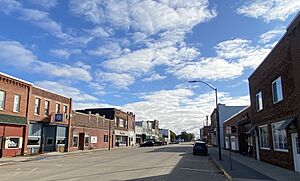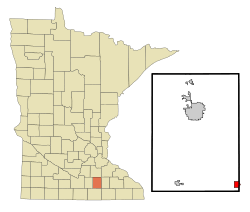Blooming Prairie, Minnesota facts for kids
Quick facts for kids
Blooming Prairie
|
|
|---|---|

The Blooming Prairie Commercial Historic District is listed on the National Register of Historic Places.
|
|

|
|
| Country | United States |
| State | Minnesota |
| Counties | Steele, Dodge |
| Area | |
| • Total | 1.36 sq mi (3.52 km2) |
| • Land | 1.36 sq mi (3.52 km2) |
| • Water | 0.00 sq mi (0.00 km2) |
| Elevation | 1,296 ft (395 m) |
| Population
(2020)
|
|
| • Total | 1,974 |
| • Density | 1,451.47/sq mi (560.30/km2) |
| Time zone | UTC-6 (Central (CST)) |
| • Summer (DST) | UTC-5 (CDT) |
| ZIP code |
55917
|
| Area code(s) | 507 |
| FIPS code | 27-06580 |
| GNIS feature ID | 2394195 |
| Website | www.bloomingprairie.com |
Blooming Prairie is a small city in the state of Minnesota, USA. It is located in both Dodge and Steele counties. Most of the city is in Steele County, with only a small part extending into Dodge County.
In 2020, about 1,974 people lived in Blooming Prairie. It's a friendly community with a rich history.
Contents
History of Blooming Prairie
Blooming Prairie was officially planned and laid out in 1868. It got its name from the surrounding area, Blooming Prairie Township, which was formed a year earlier. A post office opened in the city in 1868, helping people send and receive mail. The city officially became a city in 1874.
The historic downtown area of Blooming Prairie is very special. It is listed on the National Register of Historic Places. This means it is recognized for its important history and architecture.
Early Days and Local Stories
Blooming Prairie was once a busy place because of its location. It was near where four counties met: Mower, Freeborn, Dodge, and Steele. This made it a center for trade and activity.
Local stories say that during a time called the Prohibition Act, people dug tunnels under businesses on Main Street. These tunnels were used for secret activities. This shows how resourceful and creative people were in the past.
Geography and Location
Blooming Prairie covers a total area of about 1.41 square miles (3.52 square kilometers). All of this area is land. There are no large lakes or rivers within the city limits.
Main Roads and Travel
Two important roads pass through Blooming Prairie. These are U.S. Highway 218 and Minnesota State Highway 30. These highways help people travel to and from the city. They connect Blooming Prairie to other towns and cities in Minnesota.
People of Blooming Prairie
Blooming Prairie has seen its population grow and change over many years. Here is a look at how many people have lived in the city since 1880:
| Historical population | |||
|---|---|---|---|
| Census | Pop. | %± | |
| 1880 | 338 | — | |
| 1890 | 808 | 139.1% | |
| 1900 | 855 | 5.8% | |
| 1910 | 854 | −0.1% | |
| 1920 | 1,012 | 18.5% | |
| 1930 | 1,046 | 3.4% | |
| 1940 | 1,205 | 15.2% | |
| 1950 | 1,442 | 19.7% | |
| 1960 | 1,778 | 23.3% | |
| 1970 | 1,804 | 1.5% | |
| 1980 | 1,969 | 9.1% | |
| 1990 | 2,043 | 3.8% | |
| 2000 | 1,933 | −5.4% | |
| 2010 | 1,996 | 3.3% | |
| 2020 | 1,974 | −1.1% | |
| U.S. Decennial Census | |||
Life in Blooming Prairie (2010 Census)
In 2010, there were 1,996 people living in Blooming Prairie. There were 802 households, which are groups of people living together. About 535 of these were families.
Most people in the city were White (97.1%). A small number of people were from other racial backgrounds. About 6.3% of the population identified as Hispanic or Latino.
The average age of people in Blooming Prairie was about 40.5 years old.
- About 25.9% of residents were under 18 years old.
- About 21.2% were 65 years old or older.
This shows that Blooming Prairie is a place where people of all ages live.
Famous People from Blooming Prairie
Some notable people have come from Blooming Prairie:
- Josh Braaten: He is an actor who has appeared in television shows and movies.
- John George Lennon (1858-1919): He was a state legislator in Minnesota and a businessman.
- Samuel A. Rask (1874-1959): He served as a state senator in Minnesota and was also a businessman.
Images for kids
See also
 In Spanish: Blooming Prairie (Minnesota) para niños
In Spanish: Blooming Prairie (Minnesota) para niños




